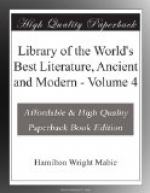“You see the memory of the Peninsula. What were we saying yesterday? Spain places her own seal upon everything that belongs to her—people, buildings, all. What you see here is the central Institute of our People, the Sephardim—the Spanish part of our People. Here is our synagogue, here are schools, alms-houses, residence of the Rabbi, and all sorts of things. You can come here sometimes and think of Spain, where your ancestors lived. Many generations in Spain have made you—as they have made me—a Spaniard.”
They went back to the first court. On their way out, as they passed the synagogue, there came running across the court a girl of fifteen or so. She was bareheaded; a mass of thick black hair was curled round her shapely head; her figure was that of an English girl of twenty; her eyes showed black and large and bright as she glanced at the group standing in the court; her skin was dark; she was oddly and picturesquely dressed in a grayish-blue skirt, with a bright crimson open jacket. The color seemed literally to strike the eye. The girl disappeared under a doorway, leaving a picture of herself in Francesca’s mind—a picture to be remembered.
“A Spanish Jewess,” said Emanuel. “An Oriental. She chooses by instinct the colors that her great-grandmother might have worn to grace the triumph of David the King.”
BESTIARIES AND LAPIDARIES
BY L. OSCAR KUHNS
One of the marked features of literary investigation during the present century is the interest which it has manifested in the Middle Ages. Not only have specialists devoted themselves to the detailed study of the Sagas of the North and the great cycles of Romance in France and England, but the stories of the Edda, of the Nibelungen, and of Charlemagne and King Arthur have become popularized, so that to-day they are familiar to the general reader. There is one class of literature, however, which was widespread and popular during the Middle Ages, but which is to-day known only to the student,—that is, the so-called Bestiaries and Lapidaries, or collections of stories and superstitions concerning the marvelous attributes of animals and of precious stones.
The basis of all Bestiaries is the Greek Physiologus, the origin of which can be traced back to the second century before Christ. It was undoubtedly largely influenced by the zooelogy of the Bible; and in the references to the Ibex, the Phoenix, and the tree Paradixion, traces of Oriental and old Greek superstitions can be seen. It was from the Latin versions of the Greek original that translations were made into nearly all European languages. There are extant to-day, whole or in fragments, Bestiaries in German, Old English, Old French, Provencal, Icelandic, Italian, Bohemian, and even Armenian, Ethiopic, and Syriac. These various versions differ more or less in the arrangement and number of the animals described, but all point back to the same ultimate source.




